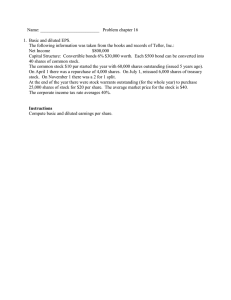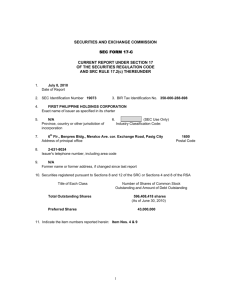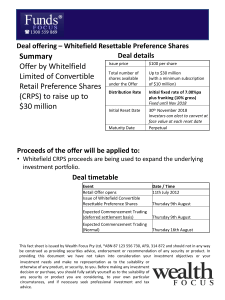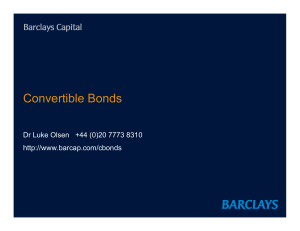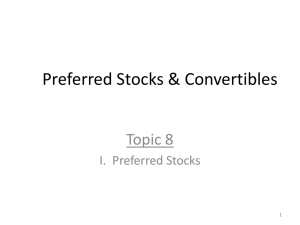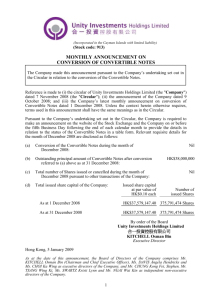Issuer Stock Borrow Facilities
advertisement
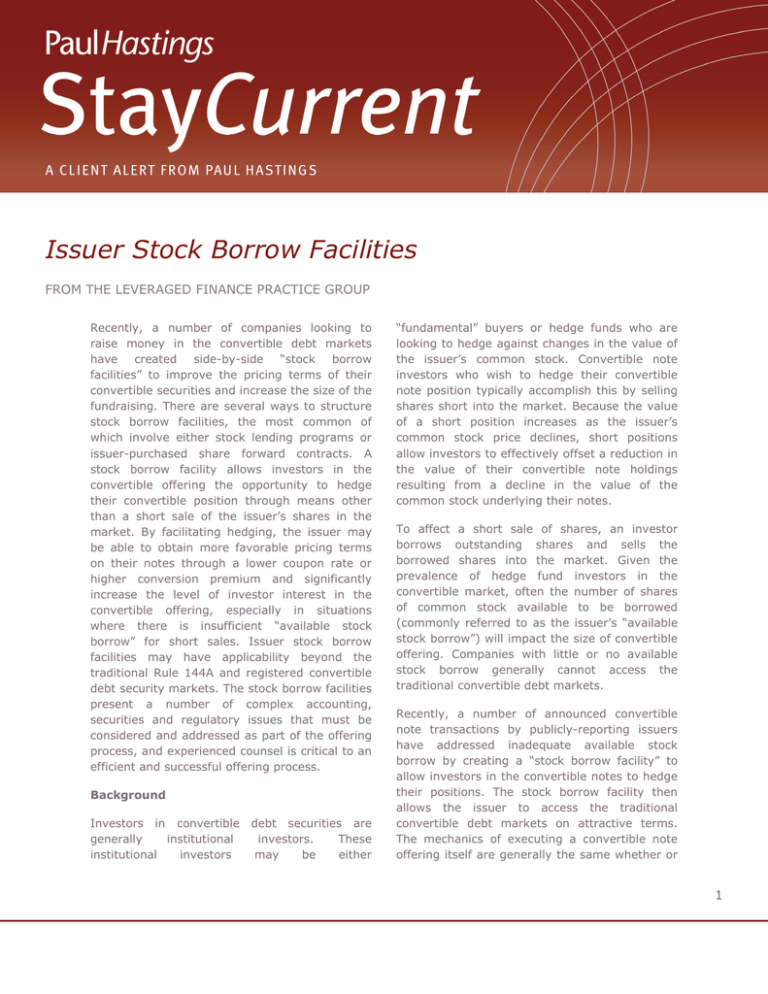
Issuer Stock Borrow Facilities FROM THE LEVERAGED FINANCE PRACTICE GROUP Recently, a number of companies looking to raise money in the convertible debt markets have created side-by-side “stock borrow facilities” to improve the pricing terms of their convertible securities and increase the size of the fundraising. There are several ways to structure stock borrow facilities, the most common of which involve either stock lending programs or issuer-purchased share forward contracts. A stock borrow facility allows investors in the convertible offering the opportunity to hedge their convertible position through means other than a short sale of the issuer’s shares in the market. By facilitating hedging, the issuer may be able to obtain more favorable pricing terms on their notes through a lower coupon rate or higher conversion premium and significantly increase the level of investor interest in the convertible offering, especially in situations where there is insufficient “available stock borrow” for short sales. Issuer stock borrow facilities may have applicability beyond the traditional Rule 144A and registered convertible debt security markets. The stock borrow facilities present a number of complex accounting, securities and regulatory issues that must be considered and addressed as part of the offering process, and experienced counsel is critical to an efficient and successful offering process. Background Investors in convertible generally institutional institutional investors debt securities are investors. These may be either “fundamental” buyers or hedge funds who are looking to hedge against changes in the value of the issuer’s common stock. Convertible note investors who wish to hedge their convertible note position typically accomplish this by selling shares short into the market. Because the value of a short position increases as the issuer’s common stock price declines, short positions allow investors to effectively offset a reduction in the value of their convertible note holdings resulting from a decline in the value of the common stock underlying their notes. To affect a short sale of shares, an investor borrows outstanding shares and sells the borrowed shares into the market. Given the prevalence of hedge fund investors in the convertible market, often the number of shares of common stock available to be borrowed (commonly referred to as the issuer’s “available stock borrow”) will impact the size of convertible offering. Companies with little or no available stock borrow generally cannot access the traditional convertible debt markets. Recently, a number of announced convertible note transactions by publicly-reporting issuers have addressed inadequate available stock borrow by creating a “stock borrow facility” to allow investors in the convertible notes to hedge their positions. The stock borrow facility then allows the issuer to access the traditional convertible debt markets on attractive terms. The mechanics of executing a convertible note offering itself are generally the same whether or 1 not the issuer is creating a stock borrow facility. Stock Borrow Facility Stock borrow facilities can be accomplished either (i) by means of the issuer entering into a stock lending agreement with a stock lending agent (usually an affiliate of the underwriter of the convertible notes), whereby the issuer loans authorized but un-issued shares to the lending agent, or (ii) by means of the issuer entering into a prepaid forward contract with the underwriter or an affiliate of the underwriter, whereby the issuer agrees on the contract date to purchase shares at a fixed price on the maturity date of the convertible notes. The purchase price of the shares is typically paid upfront from the proceeds of the convertible offering, which, as discussed further below, reduces the issuer’s net proceeds. In certain instances, however, it may be possible for the issuer to delay payment of the purchase price until the maturity of the bonds, giving the issuer access to all the proceeds of the offering in the interim. Stock Lending Program A number of recently announced convertible notes offerings with stock borrow facilities have been completed using a stock lending program. To execute a stock lending program, the issuer loans common shares to a lending agent concurrently with the offer and sale of the notes. The lending agent is typically an affiliate of one of the underwriters of the convertible debt offering. The loaned shares may be newly-issued shares, treasury shares or a combination of both. The share loan is governed by a stock lending agreement which requires the lending agent to return the shares once the bonds are converted, repurchased or repaid. The lending agent generally pays a nominal fee for the loan. Even though considered outstanding for corporate law purposes, as discussed below, since the shares are required to be returned, accountants may take the view that the loaned shares are not “outstanding” for purposes of calculating US GAAP earnings per share. Once the shares are borrowed, the lending agent will sell some or all of the shares short into the market, often in a marketed registered offering pursuant to a prospectus filed by the issuer. Given the prospectus delivery requirements for the sales, establishing a stock lending program is generally easier for issuers who have filed or can file a shelf registration statement for a primary offering with the SEC. If an issuer is unable to register the shares, it still may be possible to establish a share lending arrangement, but the transaction will likely be significantly more complicated. Once the lending agent has sold the shares short, the lending agent is in a position to transfer the short position to convertible note holders, either through equity swap arrangements or directly, depending upon the legal requirements. Regulation M under and Section 16 of the Securities Exchange Act of 1934 (the “Exchange Act”), exchange listing requirements, public offering “integration” and other securities issues often drive the structuring of the share lending arrangement. Share “double prints”, total return swaps and share lending size restrictions may be used to address some of the legal concerns. Notwithstanding the EPS accounting treatment, the shares loaned by the issuer to the lending agent will generally be deemed "outstanding" for corporate law, and the loan of the shares may be viewed as an issuance of the shares for corporate law, balance sheet presentation and securities law purposes. Additionally, the NASDAQ Office of General Counsel has provided us with verbal guidance with respect to certain touch points that may arise under a stock lending program carried out by companies listed on the NASDAQ Global Market or the NASDAQ Global Select Market. Under SEC rules, a transaction commenced as a private placement must remain private and cannot be “integrated” with a registered offering. As a result, to the extent the shares borrowed through a lending program are sold in an offering registered with the SEC, the initial sale and issuance of the convertible notes by the issuer that forms a part of the same transaction will also likely need to be registered. 2 Prepaid Forward Contract to Repurchase Stock As an alternative to implementing a share lending program, an issuer can create a stock borrow facility through a prepaid forward contract, which is entered into with the underwriter (or an affiliate of the underwriter) in lieu of a share lending agreement. A prepaid forward contract is an agreement between the issuer and the underwriter whereby the issuer agrees today to repurchase common stock at a fixed price if the convertible notes are converted, repurchased or repaid. By entering into the prepaid forward contract, the underwriter (or its affiliate) is agreeing to deliver shares in the future that it does not own on the contract date. This agreement to deliver shares it does not own is effectively a “short” position in the issuer’s common stock. The underwriter can transfer this short position to the convertible note investors via a swap transaction, and thereby allow the investor to hedge its position in the convertible notes. This enables the convertible note investors to hedge their position without borrowing and selling shares into the market. From the issuer’s perspective, their agreement to repurchase their shares has the added benefits of mitigating the potential dilution from the convertible note offering and reducing the amount of short selling into the market that would otherwise result from the offering. The net result to the issuer from a prepaid forward contract is quite similar to a share lending program, since both create a short position that can be transferred to the convertible note investors, thereby allowing them to hedge their positions without borrowing shares in the market. The prepaid forward contract, however, will typically result in the issuer receiving lower proceeds from the convertible offering since a portion of the proceeds is used to repurchase shares under the prepaid forward contract. The amount of proceeds required is a function of a number of things including the size of the conversion premium, the portion of the offering being sold to hedge funds, and the expected volatility of the issuer’s stock price. In the share lending context, the issuer is not required to use any of the proceeds in connection with the loaning of the shares. To realize the maximum proceeds from an offering, it may be possible, in certain circumstances, for the issuer to finance the cost of the repurchase either by upsizing the convertible transaction or implementing a sideby-side loan agreement with a commercial bank or other financial institution. However, unlike the typical share lending program, a prepaid forward contract can be executed on a private basis, allowing issuers, who may not have an effective shelf registration statement or who may not be able to issue registered shares, quick access to the convertible debt market. Prepaid forward contracts can implicate a number of legal, regulatory, accounting and tax issues, including Section 16 of the Exchange Act, exchange listing requirements, FAS 150 and EITF 00-19, and need to be structured with these issues in mind. Conclusion By allowing convertible note holders to hedge their positions, stock borrow facilities have the potential to significantly enhance the terms of a convertible note offering, and may allow companies access to the convertible debt markets when they would not otherwise be able to do so, absent the stock borrow facility. These transactions, however, present a number of difficult accounting, securities and regulatory issues; issuers and their agents should clearly understand the components and implications of these stock borrow facilities before including them as part of an offering. 3 If you have any questions concerning these developing issues, please do not hesitate to contact any of the following Paul Hastings lawyers: Palo Alto New York Robert Claassen 650-320-1884 robertclaassen@paulhastings.com Jeffrey Pellegrino 212-318-6932 jeffreypellegrino@paulhastings.com David Dedyo 650-320-1837 daviddedyo@paulhastings.com Michael Zuppone 212-318-6906 michaelzuppone@paulhastings.com San Francisco Jeff Hartlin 858-720-2696 jeffhartlin@paulhastings.com 18 Offices Worldwide Paul, Hastings, Janofsky & Walker LLP www.paulhastings.com StayCurrent is published solely for the interests of friends and clients of Paul, Hastings, Janofsky & Walker LLP and should in no way be relied upon or construed as legal advice. The views expressed in this publication reflect those of the authors and not necessarily the views of Paul Hastings. For specific information on recent developments or particular factual situations, the opinion of legal counsel should be sought. These materials may be considered ATTORNEY ADVERTISING in some jurisdictions. Paul Hastings is a limited liability partnership. Copyright © 2008 Paul, Hastings, Janofsky & Walker LLP. IRS Circular 230 Disclosure: As required by U.S. Treasury Regulations governing tax practice, you are hereby advised that any written tax advice contained herein or attached was not written or intended to be used (and cannot be used) by any taxpayer for the purpose of avoiding penalties that may be imposed under the U.S. Internal Revenue Code. 4
